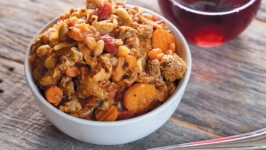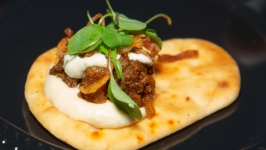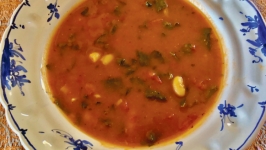Ingredients
- 2 cups rice
- 1 cup lentils
- 1 teaspoon salt
- 1 teaspoon baking powder
Instructions
DAY 1: Prep the ingredients
The back story is you have to start a couple of days in advance. Take 2 cups rice and 1 cup lentils and soak them in 4 cups of water. Lightly cover and let sit at room temperature for 24 hours. Any kind of rice will work: short or long grain, white, brown or black. Any kind of lentils will work: green, red, black or white, urad dal. The magic of fermentation starts. As the rice and lentils rehydrate, naturally occurring bacteria and yeasts wake up and come to life.
DAY 2: Start the batter
Grind the mixture as finely as possible. Let your blender or food processor run awhile, until the batter is smooth. (I use a high-power Vita Mix blender. Buy a rebuilt one online. They’re expensive but you’ll never regret it and they last a lifetime.) Now add 1 teaspoon salt.
Put this batter in a spacious container that will hold it even if it doubles in size. Cover lightly and let sit for a day or two. After the grinding, beneficial yeasts and bacteria explode with energy. They multiply rapidly and eat away at complex starch molecules, breaking them down into more digestible sugars and amino acids, adding enzymes, producing the acids that taste sour, and releasing gasses. The batter rises. It’s alive with activity.
DAY 3: Ready ... or not
When the batter rises the dosa pancakes are ready to cook or to store. If you don’t want to make the pancakes right away, the batter will keep refrigerated up to 7 days. Right before cooking add 1 teaspoon baking powder. Stir well and add enough additional water to make a medium-thick batter—the thicker the batter, the thicker the pancake and vice versa. So start thick and then thin to your desired consistency.
I always make pancakes in cast iron. It holds and disperses the heat so much more evenly than any other cookware and has a nonstick surface that will not degrade into toxic chemicals. Heat a wide skillet over a medium-high heat and film it with vegetable oil. When a drop of water sizzles on the skillet, you are ready to fry. If the oil smokes, your fire is set too high. Pour in ⅓ cup of batter and let it settle. Watch closely as bubbles rise, burst and set. When the top is almost dry, flip the pancake over and continue cooking a few more minutes until the underside is lightly browned. If your pancake is too thick, add water to the batter. Repeat and continue. This recipe makes about 8 (4½-inch) pancakes.
EAT IMMEDIATELY ... or not
The dosa pancakes are delicious for breakfast with scrambled eggs or Asian Pear Chutney. (See recipe below.) If you start the chutney when you soak the rice and lentils they’ll be ready at the same time. Reheat the pancakes in a dry skillet for lunch or dinner. Or cut into wedges and serve with dips. I had a dosa pancake, smoked turkey and Muenster cheese sandwich with lettuce, tomato and mustard today for lunch.









